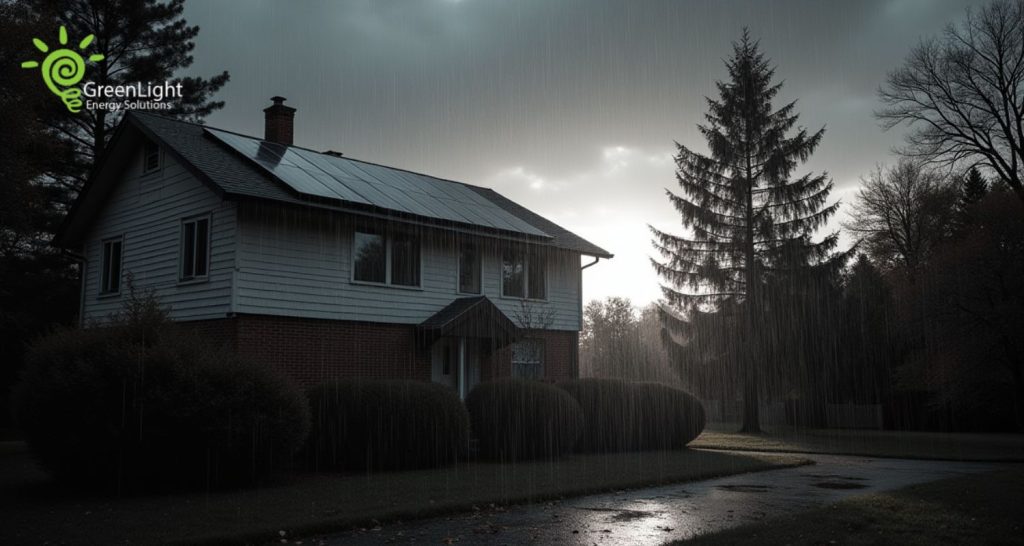Solar power is a game-changer for Australian households, but many wonder: Do solar panels work in the rain? The simple answer is yes, but at reduced efficiency.
Rainy weather means less direct sunlight, which lowers a panel’s energy output. However, solar panels can still generate between 10% and 25% of their usual capacity on rainy days by capturing diffused sunlight that passes through clouds. In some cases, rain even benefits solar panels by washing away dust and debris, improving efficiency once the skies clear.
Understanding how solar panels perform in wet conditions is essential, especially for homeowners in rain-prone cities like Melbourne, Sydney, and Hobart.
How Do Solar Panels Work in the Rain?
Solar panels generate electricity using photovoltaic (PV) cells, which absorb light particles (photons) from the sun. While direct sunlight provides the highest efficiency, diffused sunlight—scattered by clouds and rain—still carries energy that panels can convert into electricity.
Will solar panels generate electricity when it’s raining?
Yes, solar panels generate electricity in the rain, but at a reduced efficiency of around 10-25%. Light still penetrates through rain and clouds, allowing panels to capture and convert solar energy into usable electricity. However, the output depends on factors like rain intensity, cloud thickness, and the type of solar panels used.
The Effect of Rain on Solar Panel Efficiency
While rain temporarily reduces solar panel output, it also plays a crucial role in panel maintenance. Here’s how:
1. Reduced Sunlight = Lower Energy Production
Heavy rain blocks and scatters sunlight, reducing a panel’s ability to generate electricity. However, modern panels are designed to operate efficiently even in low-light conditions, ensuring that homes still receive power.
2. Rain Keeps Panels Clean
Over time, dirt, dust, bird droppings, and pollution build up on solar panels, reducing their efficiency. Rain naturally washes away debris, improving performance when the sun returns. This is especially beneficial in dry and dusty regions like Perth and Adelaide.
3. Temperature Regulation
Solar panels operate more efficiently in cooler temperatures. Rain helps cool the panels, preventing overheating and ensuring optimal energy conversion once direct sunlight is available again.
What happens to solar panels during heavy rain?
Solar panels experience a significant drop in efficiency during heavy rain, sometimes as low as 10% of their normal capacity. However, as long as some sunlight penetrates the clouds, panels continue generating power. Rain also cleans the panels, ensuring maximum efficiency once the rain stops.
How Australia’s Climate Affects Solar Panel Performance in the Rain?
Australia experiences a diverse climate, from tropical storms in the north to steady rain in the south. Here’s how different regions are affected:
1. Rainy and Overcast Climates (Melbourne, Hobart, Sydney)
- Frequent rain can lower solar panel efficiency, but diffused sunlight still generates power.
- Monocrystalline panels (which work better in low light) are ideal for these regions.
2. Tropical and Coastal Regions (Brisbane, Cairns, Gold Coast)
- Heavy rainfall during wet seasons reduces efficiency, but strong sun exposure in dry months makes up for it.
- Installing a battery storage system ensures a consistent energy supply year-round.
3. Dry and Sunny Climates (Perth, Adelaide, Darwin)
- Less frequent rain means dust and debris accumulate on panels.
- When it does rain, it cleans the panels, improving their efficiency.
Solar Panel Waterproofing and Durability in the Rain
A common concern is whether solar panels can withstand rain. Fortunately, all modern solar panels are waterproof and designed to handle extreme weather conditions, including heavy rainfall, hail, and storms.
Are solar panels waterproof?
Yes, solar panels are fully waterproof and built to withstand heavy rain, strong winds, and even hailstorms. The electrical components are sealed and protected to prevent water damage.
How do storms affect solar panels?
- Wind Resistance: Most Australian solar panels are designed to withstand winds up to 200 km/h, making them safe even during extreme weather events.
- Hail Protection: High-quality panels are tested to endure hailstones up to 35mm in diameter, reducing the risk of damage.
- Lightning Safety: While solar panels don’t attract lightning, homes with solar systems should have proper grounding and surge protection to prevent electrical damage.
How to Maximise Solar Energy Production During Rainy Days
If you live in a region that experiences frequent rain, here are some strategies to optimise your solar system’s efficiency:
1. Choose High-Efficiency Panels
- Monocrystalline panels perform better in low-light and rainy conditions than polycrystalline panels.
- Bifacial panels capture sunlight from both sides, maximising energy absorption.
2. Install a Solar Battery System
- Batteries store excess power on sunny days, ensuring energy availability during rain and cloudy weather.
- Popular battery brands in Australia include Tesla Powerwall, LG Chem, and Sonnen.
3. Keep Panels Clean
- Even though rain helps wash away dirt, regular cleaning prevents stubborn debris from reducing efficiency.
- Professional cleaning services are recommended for panels installed at steep angles.
4. Optimise Panel Placement
- North-facing panels generate the most power in Australia.
- Panels should be installed at the correct tilt angle to capture maximum sunlight.
5. Consider a Grid-Tied System
- A grid-connected system ensures a backup energy supply when solar production is low.
Final Thoughts: Are Solar Panels Effective in the Rain?
Absolutely! Even in rainy conditions, solar panels generate power, ensuring a steady energy supply.
While heavy rain reduces efficiency, it also provides long-term benefits by keeping panels clean and preventing overheating. With the proper setup—including battery storage and high-efficiency panels—solar power remains a reliable and cost-effective energy source, even in Australia’s rainiest regions.







